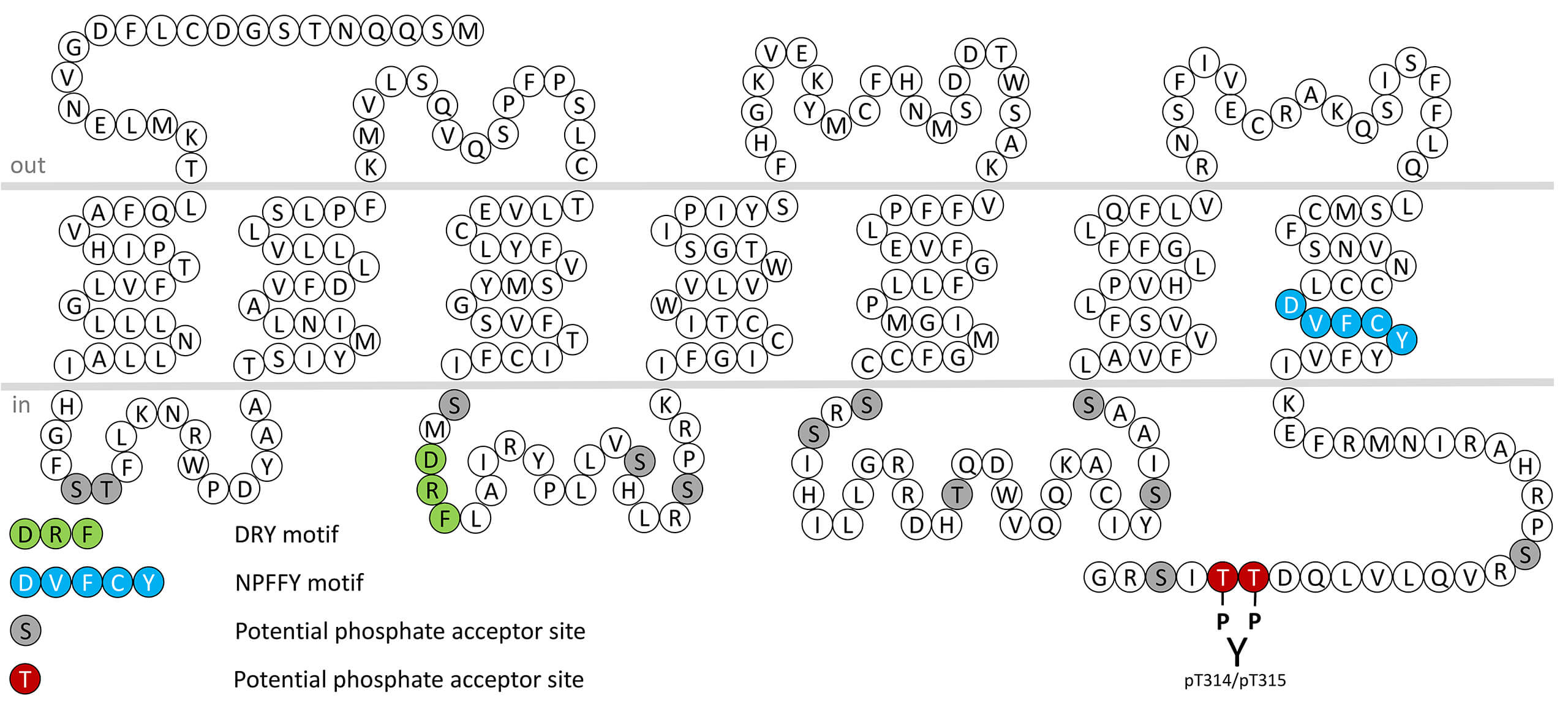GPR55 Receptor Antibodies
 The G protein–coupled receptor 55 (GPR55) is a class A GPCR that has been proposed as an atypical cannabinoid receptor, though it is pharmacologically distinct from the classical CB₁ and CB₂ receptors. GPR55 primarily couples to Gα₁₃ and Gq proteins, activating RhoA, phospholipase C (PLC), and ERK/MAPK signaling pathways, which lead to increased intracellular calcium and modulation of cell proliferation and motility. Its endogenous ligand is thought to be lysophosphatidylinositol (LPI), although certain cannabinoids—including Δ⁹-tetrahydrocannabinol (THC) and some synthetic cannabinoids—can also activate or modulate the receptor. GPR55 is expressed in various tissues, including the brain (notably the cerebellum, hippocampus, and striatum), endothelium, spleen, adrenal glands, gastrointestinal tract, pancreas, and bone. Functionally, GPR55 has been implicated in diverse physiological and pathological processes, including pain perception, bone remodeling, metabolic regulation, immune modulation, and cancer cell proliferation. In the central nervous system, it may influence motor coordination and synaptic plasticity, while in peripheral tissues, it contributes to energy metabolism and vascular tone. Pharmacologically, selective agonists (such as LPI and O-1602) and antagonists (such as CID16020046) have been developed to probe its function, though ligand specificity remains an area of debate. Overall, GPR55 represents a noncanonical lipid-sensing receptor that integrates endocannabinoid-like and lysophospholipid signaling, with emerging therapeutic potential in pain, inflammation, metabolic disorders, and cancer. For more information on GPR55 pharmacology please refer to the IUPHAR database. For further reading refer to:
The G protein–coupled receptor 55 (GPR55) is a class A GPCR that has been proposed as an atypical cannabinoid receptor, though it is pharmacologically distinct from the classical CB₁ and CB₂ receptors. GPR55 primarily couples to Gα₁₃ and Gq proteins, activating RhoA, phospholipase C (PLC), and ERK/MAPK signaling pathways, which lead to increased intracellular calcium and modulation of cell proliferation and motility. Its endogenous ligand is thought to be lysophosphatidylinositol (LPI), although certain cannabinoids—including Δ⁹-tetrahydrocannabinol (THC) and some synthetic cannabinoids—can also activate or modulate the receptor. GPR55 is expressed in various tissues, including the brain (notably the cerebellum, hippocampus, and striatum), endothelium, spleen, adrenal glands, gastrointestinal tract, pancreas, and bone. Functionally, GPR55 has been implicated in diverse physiological and pathological processes, including pain perception, bone remodeling, metabolic regulation, immune modulation, and cancer cell proliferation. In the central nervous system, it may influence motor coordination and synaptic plasticity, while in peripheral tissues, it contributes to energy metabolism and vascular tone. Pharmacologically, selective agonists (such as LPI and O-1602) and antagonists (such as CID16020046) have been developed to probe its function, though ligand specificity remains an area of debate. Overall, GPR55 represents a noncanonical lipid-sensing receptor that integrates endocannabinoid-like and lysophospholipid signaling, with emerging therapeutic potential in pain, inflammation, metabolic disorders, and cancer. For more information on GPR55 pharmacology please refer to the IUPHAR database. For further reading refer to:
Davenport AP, Alexander SP, Sharman JL, Pawson AJ, Benson HE, Monaghan AE, Liew WC, Mpamhanga CP, Bonner TI, Neubig RR, Pin JP, Spedding M, Harmar AJ. International Union of Basic and Clinical Pharmacology. LXXXVIII. G protein-coupled receptor list: recommendations for new pairings with cognate ligands. Pharmacol Rev. 2013 May 17;65(3):967-86. doi: 10.1124/pr.112.007179. PMID: 23686350; PMCID: PMC3698937.
Alexander SP, Battey J, Benson HE, Benya RV, Bonner TI, Davenport AP, Dhanachandra Singh K, Eguchi S, Harmar A, Holliday N, Jensen RT, Karnik S, Kostenis E, Liew WC, Monaghan AE, Mpamhanga C, Neubig R, Pawson AJ, Pin JP, Sharman JL, Spedding M, Spindel E, Stoddart L, Storjohann L, Thomas WG, Tirupula K, Vanderheyden P. Class A Orphans in GtoPdb v.2023.1. IUPHAR/BPS Guide to Pharmacology CITE. 2023; 2023(1). Available from: https://doi.org/10.2218/gtopdb/F16/2023.1.
 pT314/pT315-GPR55 (phospho-GPR55 Antibody)
pT314/pT315-GPR55 (phospho-GPR55 Antibody)  GPR55 (non-phospho), G protein-coupled...
GPR55 (non-phospho), G protein-coupled... 

 The G protein–coupled receptor 55 (GPR55) is a class A GPCR that has been proposed as an atypical cannabinoid receptor, though it is pharmacologically distinct from the classical CB₁ and CB₂ receptors. GPR55 primarily couples to Gα₁₃ and Gq proteins, activating RhoA, phospholipase C (PLC), and ERK/MAPK signaling pathways, which lead to increased intracellular calcium and modulation of cell proliferation and motility. Its endogenous ligand is thought to be lysophosphatidylinositol (LPI), although certain cannabinoids—including Δ⁹-tetrahydrocannabinol (THC) and some synthetic cannabinoids—can also activate or modulate the receptor. GPR55 is expressed in various tissues, including the brain (notably the cerebellum, hippocampus, and striatum), endothelium, spleen, adrenal glands, gastrointestinal tract, pancreas, and bone. Functionally, GPR55 has been implicated in diverse physiological and pathological processes, including pain perception, bone remodeling, metabolic regulation, immune modulation, and cancer cell proliferation. In the central nervous system, it may influence motor coordination and synaptic plasticity, while in peripheral tissues, it contributes to energy metabolism and vascular tone. Pharmacologically, selective agonists (such as LPI and O-1602) and antagonists (such as CID16020046) have been developed to probe its function, though ligand specificity remains an area of debate. Overall, GPR55 represents a noncanonical lipid-sensing receptor that integrates endocannabinoid-like and lysophospholipid signaling, with emerging therapeutic potential in pain, inflammation, metabolic disorders, and cancer. For more information on GPR55 pharmacology please refer to the
The G protein–coupled receptor 55 (GPR55) is a class A GPCR that has been proposed as an atypical cannabinoid receptor, though it is pharmacologically distinct from the classical CB₁ and CB₂ receptors. GPR55 primarily couples to Gα₁₃ and Gq proteins, activating RhoA, phospholipase C (PLC), and ERK/MAPK signaling pathways, which lead to increased intracellular calcium and modulation of cell proliferation and motility. Its endogenous ligand is thought to be lysophosphatidylinositol (LPI), although certain cannabinoids—including Δ⁹-tetrahydrocannabinol (THC) and some synthetic cannabinoids—can also activate or modulate the receptor. GPR55 is expressed in various tissues, including the brain (notably the cerebellum, hippocampus, and striatum), endothelium, spleen, adrenal glands, gastrointestinal tract, pancreas, and bone. Functionally, GPR55 has been implicated in diverse physiological and pathological processes, including pain perception, bone remodeling, metabolic regulation, immune modulation, and cancer cell proliferation. In the central nervous system, it may influence motor coordination and synaptic plasticity, while in peripheral tissues, it contributes to energy metabolism and vascular tone. Pharmacologically, selective agonists (such as LPI and O-1602) and antagonists (such as CID16020046) have been developed to probe its function, though ligand specificity remains an area of debate. Overall, GPR55 represents a noncanonical lipid-sensing receptor that integrates endocannabinoid-like and lysophospholipid signaling, with emerging therapeutic potential in pain, inflammation, metabolic disorders, and cancer. For more information on GPR55 pharmacology please refer to the